Search
To search for an exact match, type the word or phrase you want in quotation marks.
A*DESK has been offering since 2002 contents about criticism and contemporary art. A*DESK has become consolidated thanks to all those who have believed in the project, all those who have followed us, debating, participating and collaborating. Many people have collaborated with A*DESK, and continue to do so. Their efforts, knowledge and belief in the project are what make it grow internationally. At A*DESK we have also generated work for over one hundred professionals in culture, from small collaborations with reviews and classes, to more prolonged and intense collaborations.
At A*DESK we believe in the need for free and universal access to culture and knowledge. We want to carry on being independent, remaining open to more ideas and opinions. If you believe in A*DESK, we need your backing to be able to continue. You can now participate in the project by supporting it. You can choose how much you want to contribute to the project.
You can decide how much you want to bring to the project.
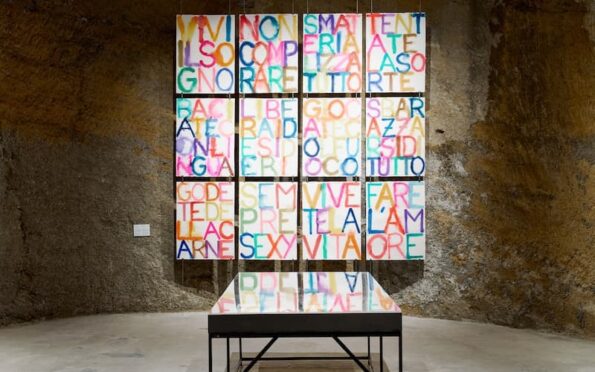
In Agrigento, a city of temples suspended between ruin and myth, the horizon opens onto a weary Mediterranean. A sea that holds both history and wounds. The exhibition Concordia: Dialoghi sui paesaggi sociali, part of the Agrigento Capitale Italiana della Cultura 2025 program, emerges as an attempt to reflect from that threshold—between history and urgency—on art’s role as a social mediator. Not merely as a mirror of conflict, but as a practice that opens spaces for listening, dialogue, and resistance.
The word Concordia is invoked here not as consensus, but as tension—a space where agreement is only possible through dissent, through the friction of perspectives. In a time when genocide, migration, and extractivist exhaustion reshape the social landscape, the curatorial proposal by Esther Regueira and Lisa Mazza acts as a rhizomatic constellation. Exhibitions, urban walks, film, conversation, and work with local communities intertwine to trace a cartography of intensities, envisioning the region not as a map, but as a network of bodies and memories.
The project departs from Agrigento—ancient Greek Akragas, a colonial, agricultural, border city—to open a dialogue between the social landscapes of the past and the urgencies of the present. If the Doric temples once symbolized power and civilization, they now emerge as ruins witnessing a new kind of procession: that of migrants, tourists, displaced bodies. Sicily has become the point of encounter (and rupture) between Africa and Europe, between history and the necropolitics of today. In response, Concordia proposes a series of artistic gestures that mediate between the visible and the unheard, between pain and possibility.
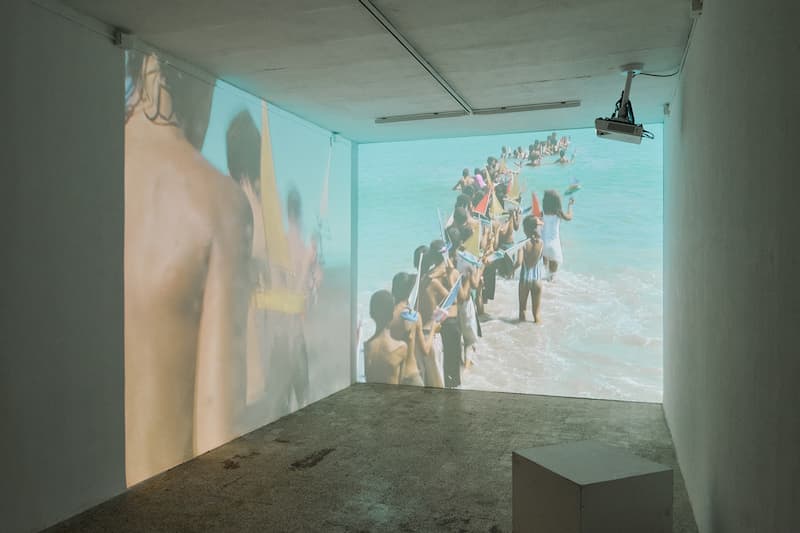
Francis Alÿs, Don’t Cross the Bridge Before You Get to the River, 2008
In the Chiesa di Santa Sofia, the dialogue between past and present unfolds through artistic strategies that reconfigure conflict. Francis Alÿs’s poetic metaphor of the Strait of Gibraltar deploys the everyday as a choreography of resistance, where minimal gestures disarm the logic of violence; Daniela Ortiz, with The ABC of Fascist Europe, confronts the exclusionary mechanisms of European migration policies from an anti-colonial stance; Muna Mussie weaves a bodily memory of the diaspora from migrant experience; and Alonso Gil proposes a decalogue without commandments—visual poems that invite us to inhabit life with fullness and awareness. Rubén Ojeda Guzmán ignites his piece—literally—in an act of reflection on borders, identities, and human rights, turning stars into ash and memory.
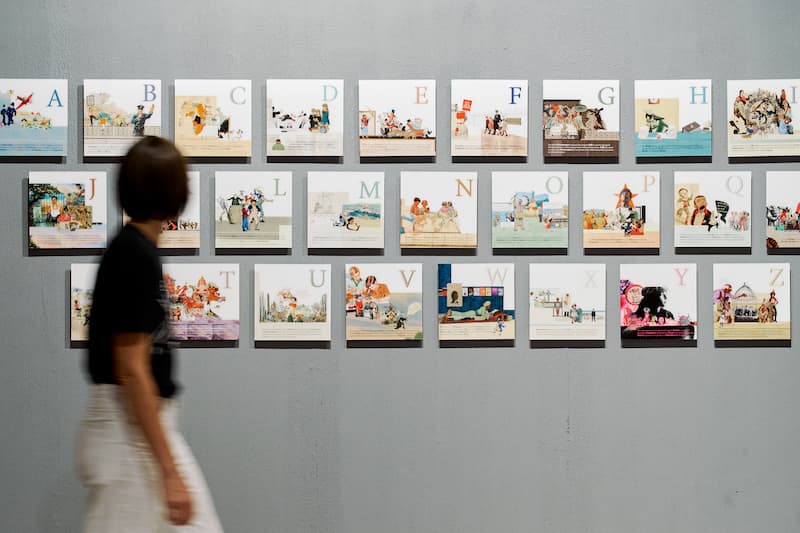
Daniela Ortiz, L’ABC dell’Europa razzista
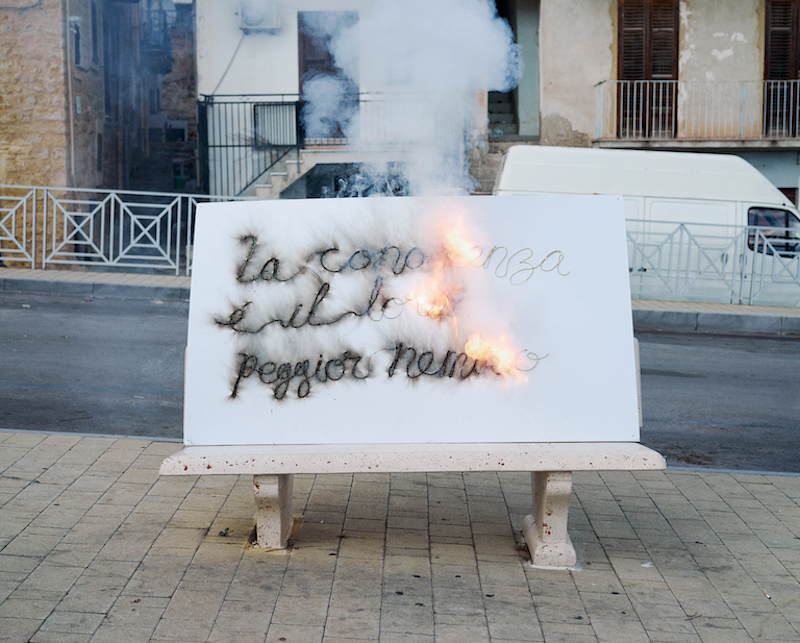
Rubén Ojeda Gúzman, Poem of Mass Destruction, 2025
The journey moves constantly between the global and the local, the epic and the everyday. Bertolt Brecht’s ABC of War, with its anti-war photomontages, shares a display with Spanish card games from the 1970s that normalized war for children. Nearby, Milva’s recording of Bella Ciao becomes an anthem of resistance echoing from the past to the present migration crises, addressed in Nicolò Degiorgis’s Mare Vostrum. A series of digital collages reinterprets the figure of Europa as a migrant through AI-generated images that repeat, like a visual echo, bodies and boats adrift at sea.
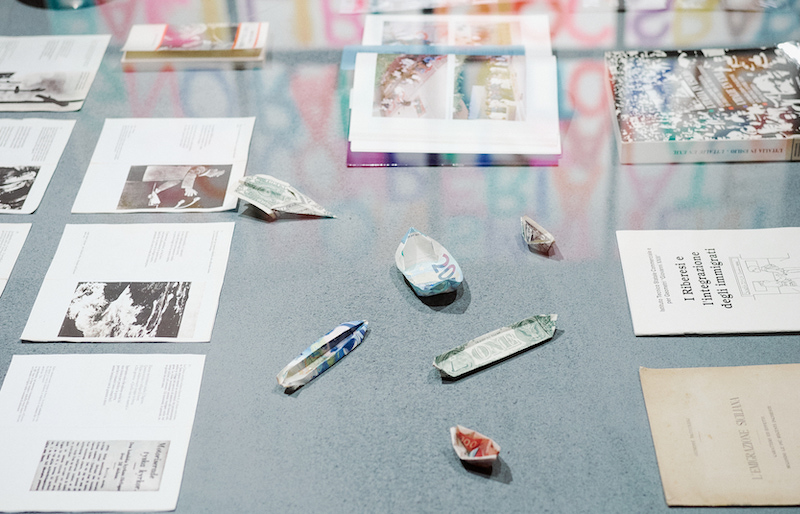
Display Cabinet: Conflicts & resistance. Left: Bertolt Brecht, ABC della GUERRA, 1975. Center: Nicolò Degiorgis,Mare Vostrum
In response, irony and sharp critique arrive through Robin Kahn’s imaginary library, Il Galateo. The work subverts etiquette manuals and codes of conduct to denounce the oppression of the “decorative woman,” celebrating female cunning as symbolized in the Sicilian legend of the Testa di Moro, where a woman transforms her unfaithful lover’s head into a flowerpot—an emblem of wit, vengeance, and rebirth. Closing this chorus is Kimika, whose work recovers the voice of the Sahrawi people, an open wound on the map of the Global South still awaiting justice.
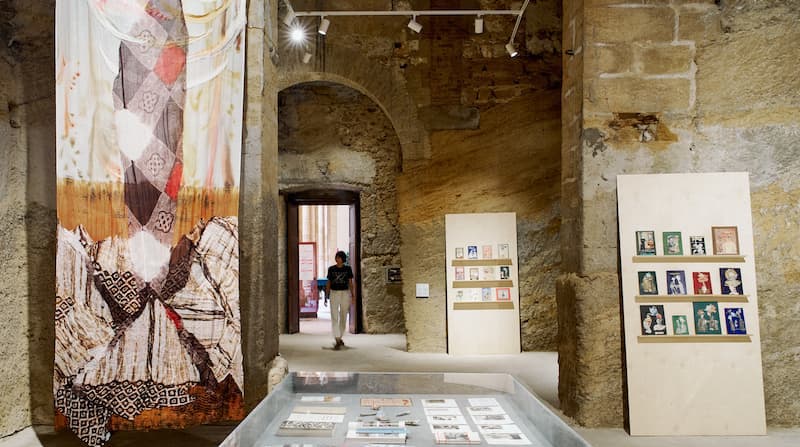
Left: Kimika, La tierra brota/ La terra germoglia, 2024. Right: Robin Kahn, Il Galateo
The polyphonic structure of the exhibition extends to the Teatro Pirandello, where Maro Michalakakos presents the sculpture Allerleirauh (2003), inspired by the Brothers Grimm fairy tale of the same name from 1857, in which a king’s desire for his own daughter reveals the perversion of power and beauty as condemnation. Alongside this gilded cage, another feminist piece, Siciliane, by writer Ester Rizzo in collaboration with curator Esther Regueira, rescues from oblivion Sicilian singers, actresses, writers, and activists—projected in a tondo format—in response to the absolute absence of women’s portraits in the theater. Siciliane demonstrates, through historical documents displayed in a second vitrine, that women have always been the social pillars of the island, even as official history insists on ignoring them.
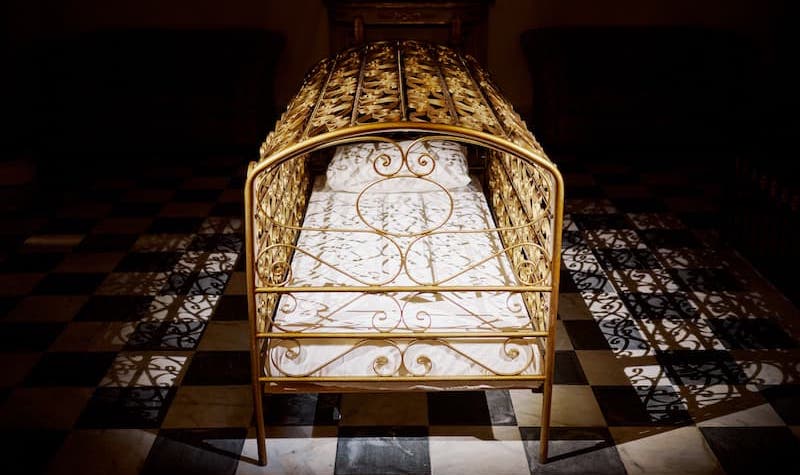
Maro Michalakakos, Allerleirauch, 2003
The situated dimension of Concordia culminates in a series of residencies where Rubén Ojeda Guzmán, experimental dance artist Yinka Esi Graves, and Alonso Gil work with local associations to create works and actions that transcend the exhibition format and embed themselves directly in the city’s daily life. Meanwhile, flamenco dancer Carmen Avilés investigates the correlation between Sicilian tarantella and flamenco taranta. Also part of the public program, the urban walks (passeggiate) led by Valeria Scavone map the city as a living archive, where architecture reveals Agrigento’s social scars.
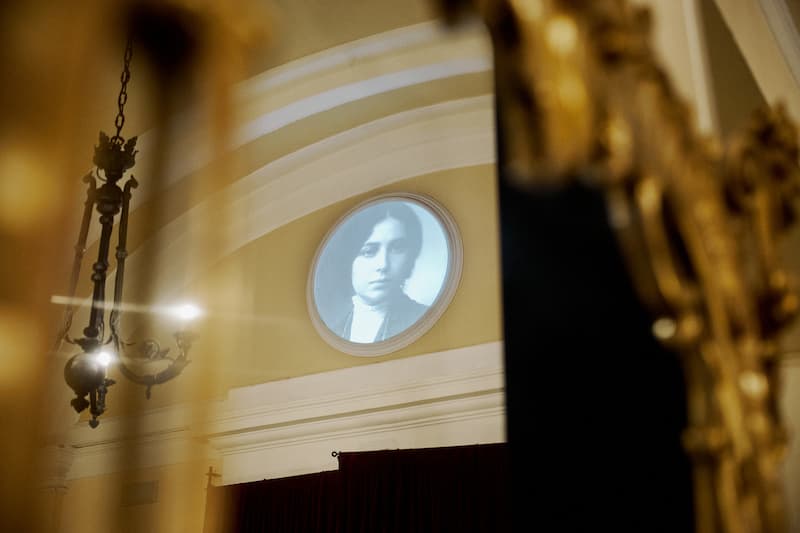
Ester Rizzo + Esther Regueira, Siciliane, 2025
During the opening weekend, Alonso Gil carried out the 10-hour-long action Vestiti delle Vita / Clothes of Life in the square facing the inclusive social platform of the Scaro Caffe collective. There, he set up an open screen-printing workshop, inviting residents and visitors to bring their own garments to be printed with images and slogans that give visibility to citizens’ ideas, desires, and thoughts, while also supporting the situation of the migrant community in Agrigento. More than an art happening, it was a gesture of collective participation—a constant flow of hands, fabrics, and pigments that transformed the square into a space of daily encounter and resistance, where art merged with life in its simplest, most communal form.
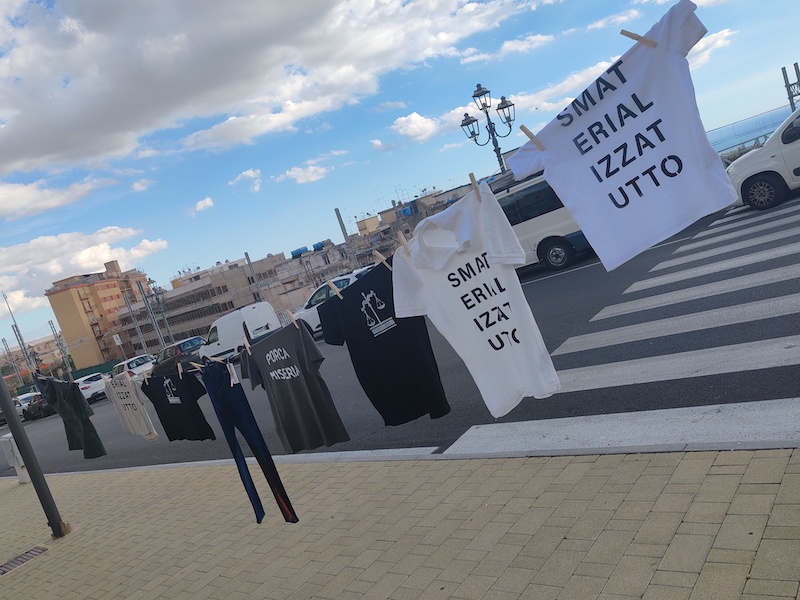
Alonso Gil, screen-printing workshop Vestiti delle Vita (Clothes of Life) in Piazza Ravanusella, Agrigento, Sicily
Concordia in collaboration with the Cervantes Institute in Palermo and the Pietro Griffo Archaeological Museum hosts Santiago Palacios’s photographs on the contemporary drama of the Mediterranean. The notion of “social landscape” thus expands to include the geography of global conflict. A fractured Mediterranean, where death, exile, and silence mingle with tourist indifference or political rhetoric. Marina Fokidis’s circular sea—that round sea where the sun, moon, and bodies revolve without hierarchy—has become a space of lethal asymmetries. In its waters float the remnants of an exhausted modernity, of a colonialism that never fully dissolved.
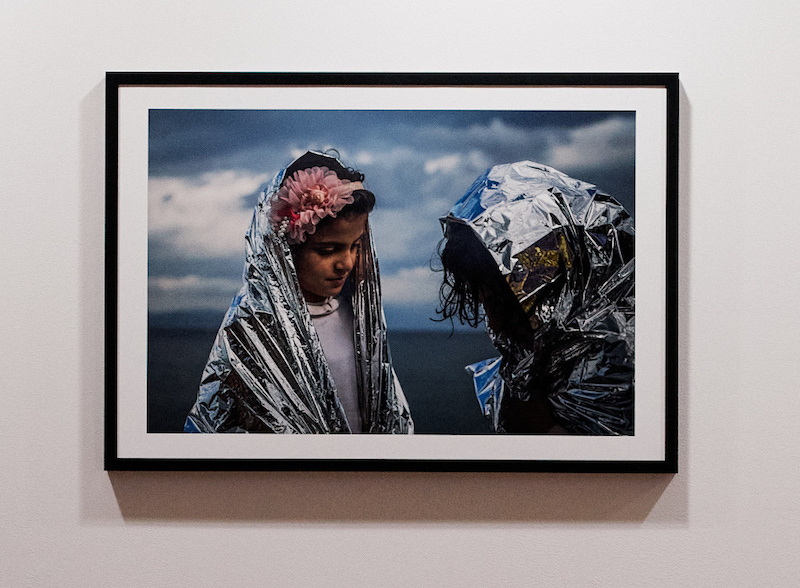
Santiago Palacios, Grecia, 2015, Mediterráneo central, 2016-2021
The curatorial approach draws on Jacques Rancière to conceive art not as a mediator between knowledge and ignorance, but between different sensorial worlds. In Concordia, this mediation expands into a triangulation of thoughts that overflow the Western framework, an “in-between space,” in Homi K. Bhabha’s sense, where differences are not resolved but negotiated and translated. In turn, dissent, as Chantal Mouffe suggests, ceases to be an obstacle and becomes a condition of coexistence. Finally, the artistic dialogue opens toward Boaventura de Sousa Santos’s Epistemologies of the South, where listening to the other also means recognizing the knowledges and sensibilities that hegemonic history has left out.
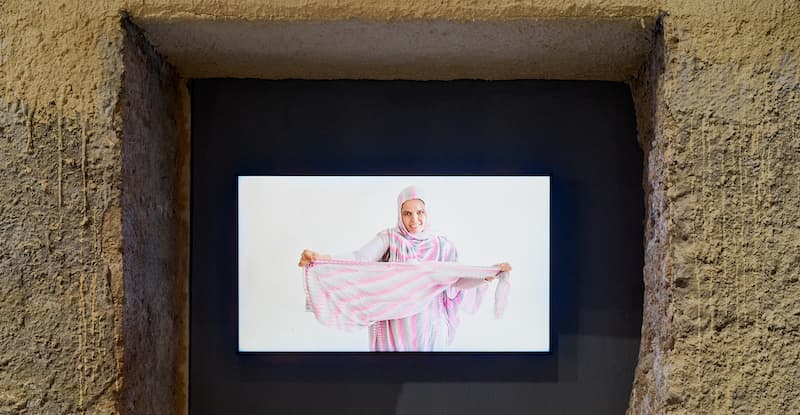
Samira, Thobe: Symbol of Resistance, 2024. Video based on photos from Palestinian Museum via Abdullah Dwakiat
On the edge—this edge that is both border and mirror—Concordia deploys a lexicon of the emancipatory power of counter-hegemonic, anti-patriarchal, anti-classist, and anti-racist cultural practices from Sicily. Because the project proposes a spherical way of thinking, like the turn of a dervish’s skirt. What goes, returns; what sinks, resurfaces. In this time suspended between systemic social ruins and reconstructions, perhaps art can help us continue to ask, again and again, what it means to live together in peace in the world today.
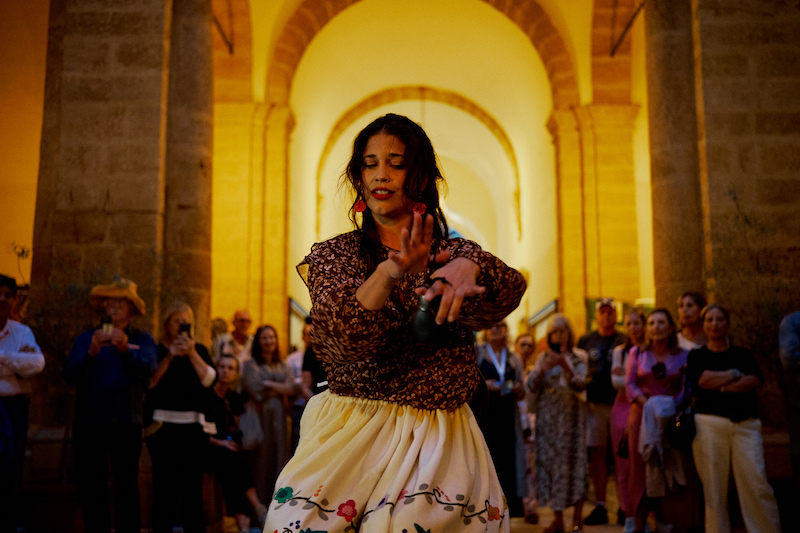
Carmen Avilés, Dialogue: taranta flamenca & tarantala siciliana, 2025
All images by Daniel Mazza © Courtesy Concordia: Dialogues on social landscapes, Agrigento Capitale Italiana della Cultura 2025.
[Cover image: Alonso Gil, I nuovi comandamenti (The New Commandments), 2025]
Concordia: Dialogues on social landscapes various locations in Agrigento until November 23. Full program info here.
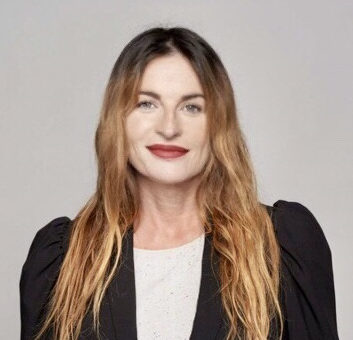
María Muñoz-Martínez is a cultural worker and educator trained in Art History and Telecommunications Engineering, this hybridity is part of her nature. She has taught “Art History of the first half of the 20th century” at ESDI and currently teaches the subject “Art in the global context” in the Master of Cultural Management IL3 at the University of Barcelona. In addition, while living between Berlin and Barcelona, she is a regular contributor to different media, writing about art and culture and emphasising the confluence between art, society/politics and technology. She is passionate about the moving image, electronically generated music and digital media.
Portrait: Sebastian Busse
"A desk is a dangerous place from which to watch the world" (John Le Carré)